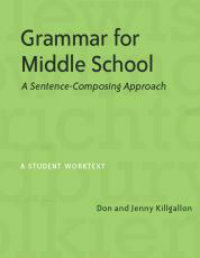Teaching Grammar: A Sentence Composing Approach
Grammar for Middle School: A Sentence-Composing Approach
By Don Killgallon and Jenny Killgallon
(Heinemann, 2006 – Learn more)
The authors of Grammar for Middle School describe the sentence-composing approach as “acrobatic training in sentence dexterity.” The book lives up to this dramatic description, guiding students to imitate and then create complex sentences with varied types of structure and syntax. While no one book can turn your class into The Flying Wallendas of sentences, this approach can give your students tools to be more daring in their writing.
The foundation of this approach is imitation. Students are given model sentences from literary texts, and they use tools to imitate the structure of these sentences. The goal, however, is creation—students make these tools their own and develop their own style in writing complex sentences.

- Words (opening adjective, delayed adjective, opening adverb, delayed adverb)
- Phrases (absolute, appositive, prepositional, participial, gerund, infinitive)
- Clauses (independent/dependent, adjective, adverb, noun)
For each tool, there is a series of activities that build in rigor and independence by slowly relying less and less on model sentences. The activities follow the same pattern for each tool:
- unscrambling (isolating sentence parts)
- combining (imitating structure by combining short sentences)
- imitating (creating their own imitation of a sentence)
- expanding (adding sentence parts to model sentences)
In addition to the student worktext, there is an online teacher’s guide that is instrumental to using this text. The worktext itself is student centered, so the online guide is essential for the why and how of the sentence combining approach. It includes background information, a comprehensive list of the model sentences and sources, suggestions for sequencing and assessing, and most importantly, tips for teaching. These tips include extensions for the lessons and provide useful ideas for differentiation, such as challenging students to add in sentence parts of different lengths (for example, one group adds short phrases, one group adds medium phrases, and another adds long phrases).
Some reflections on the book
Using sentences from authentic literary texts is an established idea in grammar instruction. I’m a big fan of Jeff Anderson’s Mechanically Inclined, so the ideas in this text aren’t groundbreaking. Although using model sentences isn’t new, the repeated cycle of exercises and the mountain of model sentences offered here provide the type of repeated exposure that students need to internalize the tools and make them their own.
One caveat—and this is a pretty big one: The title Grammar for Middle School is a little misleading. Although there are explanations for the grammatical concepts behind the tools, they are concise – more a reminder than an actual lesson. You will not find explicit instruction on, say, subject-verb agreement. What this text does address is the application of grammatical concepts. Students in middle school are just beginning to develop complex, abstract thoughts, and often their writing isn’t sophisticated enough to express them. This book gives students a voice for their thinking by providing them with the tools to write complex sentences.
Also see our review of the Killgallons’ Paragraphs for Middle School
I tried out the sentence composing approach in my classroom, and I quickly noticed that the most valuable aspect of using this approach is the sense of play that it instilled. It is hard for students to abandon the urge to try to be “right” all the time (especially with grammar instruction), and I sometimes find it difficult to get students to experiment with their writing. Having the model sentences as a scaffold freed up students’ thinking and made them willing to play with words and experiment with sentence structure. Students were actually able to laugh at their mistakes, which is invaluable.
Having the model sentences as a scaffold freed up students’ thinking and made them willing to play with words and experiment with sentence structure.
If you’re looking for a complete grammar program with mini-lessons that provide direct instruction, this is not the book for you. However, the strength of the sentence-composing approach is that it integrates grammar, writing and literature. It provides tools for students to apply grammatical skills in their own writing. Most importantly, in my experience, it also encourages a sense of play and experimentation. If you’d like to see a little more acrobatics in your students’ writing, the sentence-composing approach could be a valuable tool.
Jenny Ovadia has taught middle-school ELA in Queens, New York for eight years. She trained with the New York City Teaching Fellows and her professional interests include curriculum planning and the teaching of writing. She writes and reviews instructional materials aligned with the Common Core Learning Standards as a member of the Common Core Fellowship.
































Hello Ms. Ovadia
Thank you for your review. I will be starting my daughter with the elementary series but have a couple of questions for you:
For elementary years, do you think it’s possible that simply copying these literary sentences and then re-reading them can help to imprint the sentence structure just as well as Killgallons exercises? I see how imitation can certainly help but wondering about the “chunking exercises” or unscrambling. I’m not sure if elementary children are able to imitate well so I’m wondering if instead I should focus on reading and copying well written sentences until middle school.
Thank you
Lesli